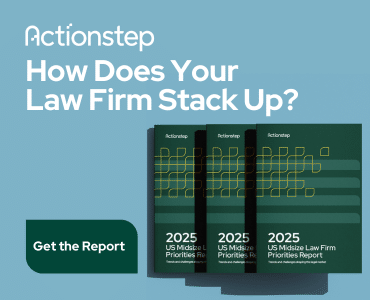If you’re spending time creating marketing content for your law firm, it’s worth understanding which social media metrics actually matter and what to do with them.

Your law firm is officially on social media, and you’ve just clicked “post” on a thoughtful, informative piece of content. You get a warm, fuzzy feeling every time a notification pops up for a new like, comment or share.
But the glow wears off, and the internet moves on. Then things get a little confusing.
Table of contents
How Do You Know if Social Media Is Worth Your Time?
Your colleagues commented on your post, but how do you know if it’s reaching potential clients, too? What do all the numbers in your analytics dashboard mean?
The numbers visible around your social media posts and the ones tucked in your analytics dashboard are valuable evidence. They’re your audience saying, “More, please,” or “Not interested, thanks.”
Don’t ignore this evidence as you throw different types of posts at the wall to see what sticks. Your wall — well, feed — is already telling you what’s likely to work.
If you’re spending time creating social media content for your law firm, it’s worth understanding which social media metrics actually matter and what to do with them.
First: Know Where to Find Your Analytics
This article focuses on the two platforms lawyers use most: LinkedIn and Facebook. According to the American Bar Association’s legal tech survey, 80% of law firms are on social media, with 78% using LinkedIn and 53% engaging on Facebook.
To check your performance on LinkedIn, go to your firm’s company page and then to the Analytics tab. There, you’ll find data on your content, visitors, followers, search appearances, leads and competitors.
On Facebook, go to your firm’s company page and then the Insights tab. You’ll find data on your views, interactions and audience. Alternatively, you can use Meta Business Suite (formerly Facebook Business Manager) for more details.
If you’re managing both platforms, LinkedIn Analytics and Facebook Insights will give you everything you need to get started. However, you may also want to employ helpful tools like Hootsuite, Sprout Social, HubSpot and Google Analytics, which allow you to dig even deeper into your performance data.
Second: Know Your Funnel
Before we dive into specific social media metrics, consider the marketing funnel. This is a framework for thinking about where your audience is on their journey toward your desired outcome (e.g., becoming a client):
- Top of funnel: The widest possible audience that is just being introduced to your firm and its legal services.
- Middle of funnel: A more engaged group that may have a legal problem and wants to learn more about how your firm can help.
- Bottom of funnel: The smallest group of people. This group includes those who are ready to take action and become a client.
At each point in the funnel, one metric matters most. Knowing where it fits helps you understand what each metric is telling you.
The Five Most Important Social Media Metrics
1. Impressions or views
Definition: Each time your post appears on someone’s screen. It doesn’t mean they have read or interacted with the post, just that it showed up in their feed.
One person can count for multiple impressions if they see your post multiple times.
Why this metric matters: Impressions matter for brand awareness and reach, which are at the top of the marketing funnel. The more people who see your content, the more awareness you are building for your firm.
Where to find this metric: Facebook Insights and LinkedIn Analytics. Both platforms show overall impressions for a specified period and impressions per post.
Legal industry average (for law firms): Your impressions will vary. Impressions are influenced by your content and who engages with it. Social media algorithms tend to show users posts that are similar to those with which they’re already interacting.
If only your followers engage, impressions may stay limited. However, if someone outside your network is tagged or interacts with the post, it may be shown to a wider audience.
Instead of focusing on a particular benchmark, prioritize an increase in your impressions over time and a higher engagement rate (we’ll cover that next).
2. Engagement rate
Definition: The percentage of people who interacted with your content out of the total impressions.
On LinkedIn, interactions can include clicks, likes, comments, reposts and follows. On Facebook, interactions include likes or reactions, saves, comments and shares.
Why this metric matters: A strong engagement rate means your content is resonating with those who see it and signals social media algorithms to show your posts to more users. This is an important metric for spreading awareness (at the top of the funnel).
A low engagement rate may mean people are scrolling past your posts without engaging. This can indicate that the content you’re posting isn’t relevant to your audience, may lack a clear call to action, or that you need more consistency in your posting schedule.
Where to find this metric: On LinkedIn, it’s included in analytics. On Facebook, calculate it yourself by dividing interactions by views.
Legal industry average: According to Hootsuite, the average engagement rate for legal and other professional services is 3.2% on LinkedIn and 1.5% on Facebook.
3. Followers
Definition: People who follow your firm’s page. You’re in the middle of the funnel now, and your followers want to learn more.
Why this metric matters: More followers can increase your reach, but quality matters more than quantity. A small, highly engaged following is more valuable than a large, uninterested one.
When you post content tailored to a specific audience, and that audience follows you, they’re more likely to engage, boosting your engagement rate and increasing the chances your posts will be favored by the algorithm. So, aim to attract people who resemble your ideal client or referral source.
Where to find this metric: In LinkedIn Analytics, you can see data about your followers’ job function, company size, industry, location and seniority. In Facebook Insights, you can see data about your followers’ age, gender, city and country. You can also manually review the profiles of people who interact with your content most often.
Legal industry average: While there is no set number, aim for steady growth among your target audience.
4. Click-through rate (CTR)
Definition: CTR is the percentage of people who clicked a link in your post. It’s especially relevant for posts that link to your website, services or other content. CTR is most relevant to users who run paid social media ads that include a link, but it is also applicable to organic (unpaid) posts.
Why this metric matters: CTR reflects how effective your content is at driving traffic where you want it to go. Some of these clicks may be bottom-of-the-funnel, from people ready to engage your services.
Where to find this metric: CTR by post is included in your LinkedIn Analytics. In the Facebook Meta Business Suite, divide the number of link clicks on a post by impressions.
Legal industry average: A good CTR is around 0.5%–1.5% for law firms and professional services. This varies by platform and whether the post is paid or organic.
5. Direct messages
Definition: The number of private messages or inquiries received in your social media inbox.
Why this metric matters: Direct messages are often a sign of serious interest. Someone who messages you likely wants to learn more about your services and may consider hiring you. Direct messages are bottom-of-the-funnel interactions.
Ethics note: Be mindful to move the conversation out of the social platform direct message and into your established intake process or other secure, confidential communication channel. Direct message conversations should not go beyond relaying information like business hours or scheduling an appointment.
Where to find this metric: Both LinkedIn and Facebook have company page inboxes. You can manually track the number and quality of messages you get over a specified period.
Legal industry average: There is no official benchmark. Instead, monitor whether your DMs are increasing and leading to meaningful conversations.
What You Can Do With This Information
You don’t have to become a full-time marketer to make social media work for your law firm. Start by tracking a few of these key social media metrics. Identify the type of content that leads to high engagement and clicks. Note when you receive an influx of quality followers or DMs. Then use what you learn to adjust your posts, refine your message and improve results over time.
Licensed under the Unsplash+ License
















